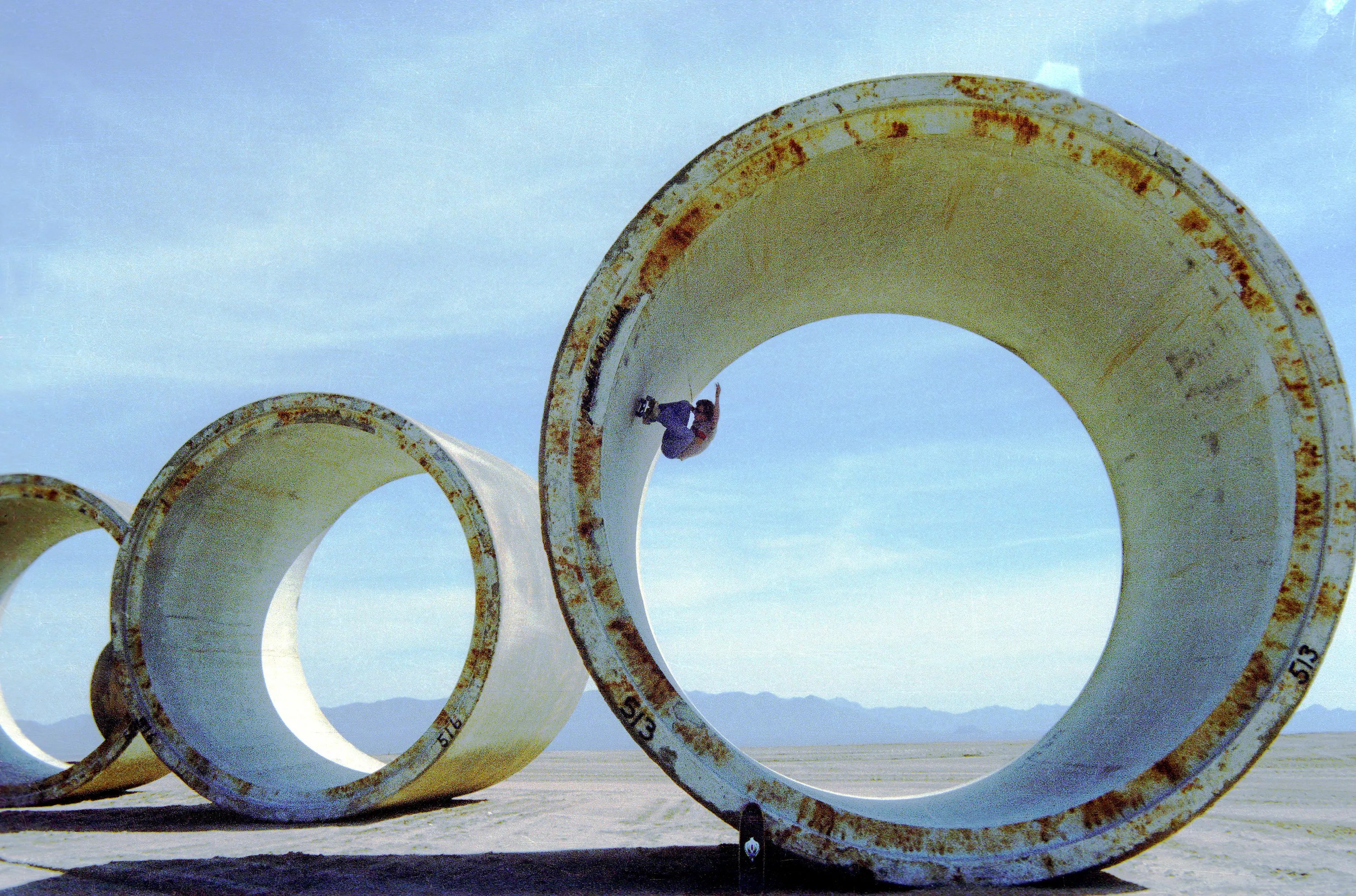
Larry Mead

Audio By Carbonatix
Right now, at the Tempe History Museum, you can see an excellent exhibit called “Dry Surf: Local Skateboarding History.” It’s more than worth a visit, even if you’re unsure about the historical significance of what was once considered a fad, a flash in the pan and in some cases, a public nuisance. There’s much to learn about the history of skateboarding in the Valley.
The exhibit unspools 60 years of local skateboarding history. Josh Roffler, the museum’s senior curator of collections, and Rob Locker of AZPX Skateboards spearheaded the effort to assemble the incredible collection of skateboards, photographs and assorted memorabilia. But it wasn’t without the help of a caring and diligent skateboard community of donors, many of whom are budding historians themselves.
A West Virginia University website about the science of sports calls a skateboard “a fantastic example of compound machines.” Over time, these machines have evolved to the point where you can buy a motorized skateboard and use it to zip around town while leaving a small carbon footprint. The equipment skateboarders used in the 1950s, ’60s and ’70s was primitive by comparison.
In the 1960s, Phoenix’s proximity to the California coast made it inevitable that the new, four-wheeled vehicle made its way east and into the hands of local youth. Just finding out that skateboards existed was enough for early adopters to get curious and allowed the first wave of skateboarders to figure out what they could do with this machine.
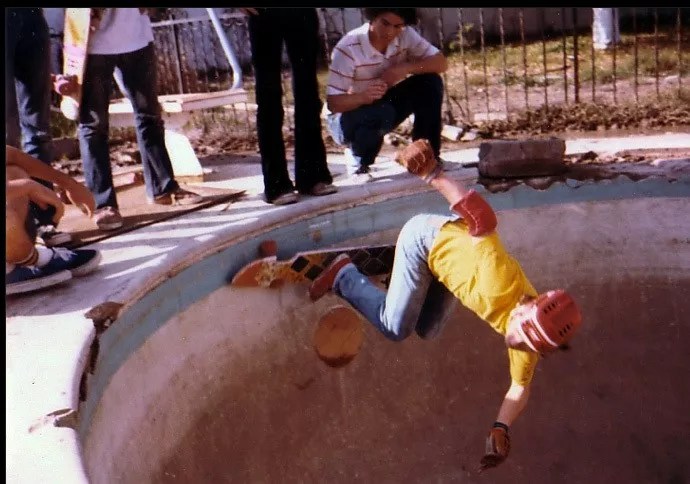
Hoss Rogers rides a long board in Howard’s bowl circa 1976.
Hoss Rogers
Tony Simon was skating in the Valley as far back as the 1960s. Along with Simon, early local adopters of the sport included Hoss Rogers, Gavin Troy, Rob Shipp, Brian Brannon, Steve Shelton, Todd Joseph and Steve “Ping” Pingleton.
The early skateboarding legends of Phoenix share some commonalities. Working with their hands is one: Simon has been a mechanic for most of his life, Pingleton just published his first book of skateboarding photography and has been an avid photographer since the 1970s, and Rogers and Troy are renowned artists in jewelry and painting, respectively.
Music is another: Brannon (Jodie Fosters Army), Joseph (Junior Achievement) and Shelton (Glass Heroes/The Brand) are have played in some of the greatest punk rock bands to ever come from Phoenix. All three men helped introduce the local skateboard scene to punk rock. If there were a Mount Rushmore of skate punk bands, JFA is definitely carved into the face.
The following are memories of the early days of the Valley skateboarding scene.
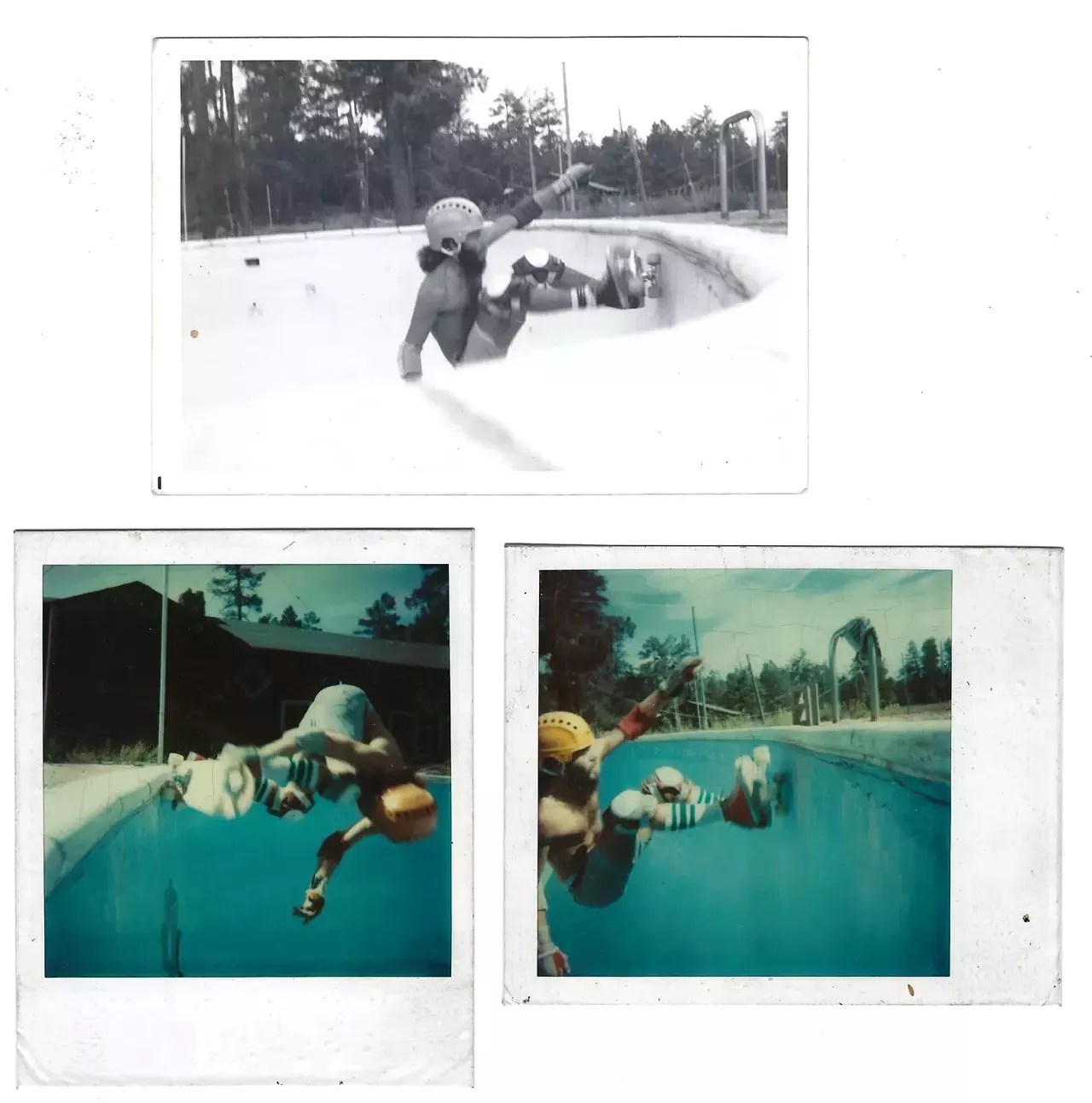
Tony Simon rides some pools in the 1970s.
Tony Simon
As you can learn from the “Dry Surf” exhibit, it’s possible that Scottsdale was home to the world’s very first skate park. It opened in 1965.
Simon: 1965 or so, that’s probably right. It was at Hayden Plaza East. There was also a Hayden Plaza West, where they had a Woolco, which was like a department store, and they had a Pride. There were two wings to the shopping center. It had a liquor store at one end and a Mexican food restaurant at the other end, with a bunch of businesses.
They built a square that was probably 50 square yards. They had steps that lined up on it and it had a downhill and then the rest of it was flat, so there were no banks (transitions) or anything like that. It was just a flat bank with a starting ramp to get some speed.
Simon began skateboarding a few years before that, in 1963.
Simon: I skated, not on any terrain (transitions such as empty pools, ramps, banked walls, etc.). You know, we didn’t know about that kind of stuff. Just pushed around on the flats. Used it for transportation in Tempe as a kid and then, you know, skateboarding just went away.
The “fad” days of skateboarding in the mid-1960s didn’t last long, as many skateboarders shifted to other interests. For the next generation, the skateboarding adventure began a decade later.
Joseph: Around 1975, my dad had a subscription to Sports Illustrated magazine. There was an article, and they’re like, “Hey, skateboarding is becoming popular again with the invention of the urethane wheel.”
I told my dad, “Oh man, that looks really cool.” It was close to my birthday, and my dad, who traveled all the time, was going to California on his next trip. For my 11th birthday, he got me my first board. I just kind of learned how to ride where we lived (in Wisconsin). There were some hills and nobody else skateboarded. In fact, nobody else knew anything about skateboarding.
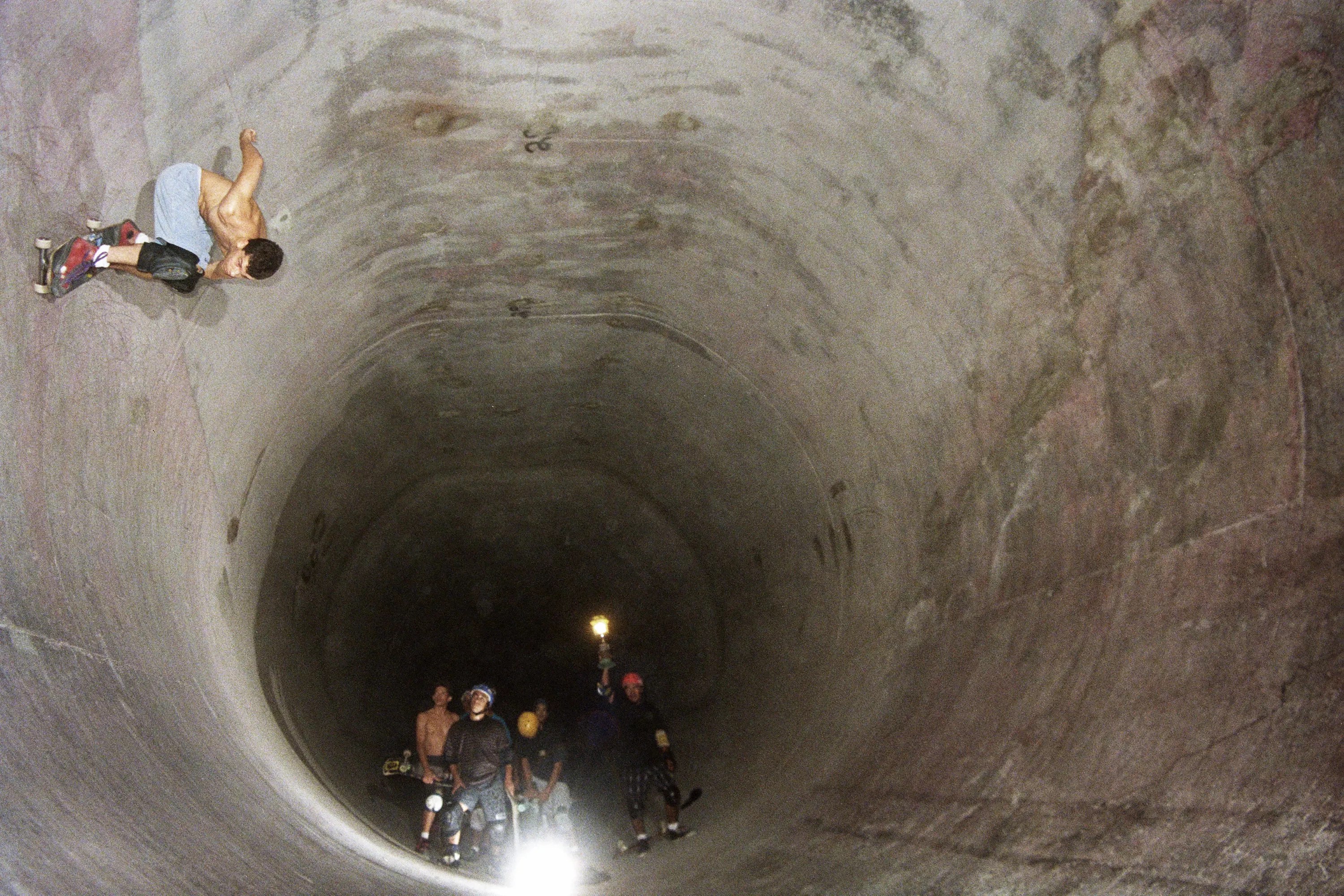
Brian Brannon in 1990 at the Florence pipes.
Ping
Brannon: I started skateboarding when I was probably about 5 or 6. My mom took me to Kmart and said I could get a skateboard. They actually had (ones with) urethane wheels, but they also had the Black Knight boards with the clay wheels. I just liked the graphic of the knight, you know, under the shining armor with the big lance, so I got that.
I was just skateboarding down the driveway, first on my stomach and on my back, pushing with my hands. I would go backwards, pushing with my hands. And then I did a thing where I would run alongside it with both hands on the board, and then jump on on my knees and push with one knee. That was how I could get going the fastest. So, I would just be going as quick as I could and turning the corners and doing that kind of stuff.
Shipp: My cousin had a roller board, which was kind of like a balance board. There was a toy company that made one in the ’60s, and my cousin had one. I learned how to do that but it wasn’t like a thing or anything like that. It was around and I was doing it, you know.
I met Hoss (Rogers) when I was 5 and the summer after, man, I want to say seventh grade, which would have been like ’75, he came back from visiting his dad or whatever, and he had a Zephyr 27-inch fiberglass, you know, which was just kind of a big step above the Logans. It was like, “Wow!” It was pretty powerful.
I started to take (skateboarding) more seriously, but there was a just a couple of other guys (who skated), and that was the only people that we knew of for a long time. It was like being on an island.
Troy: Well, I first started in 1976 when I got my first board at Kmart. I got a white Makaha.
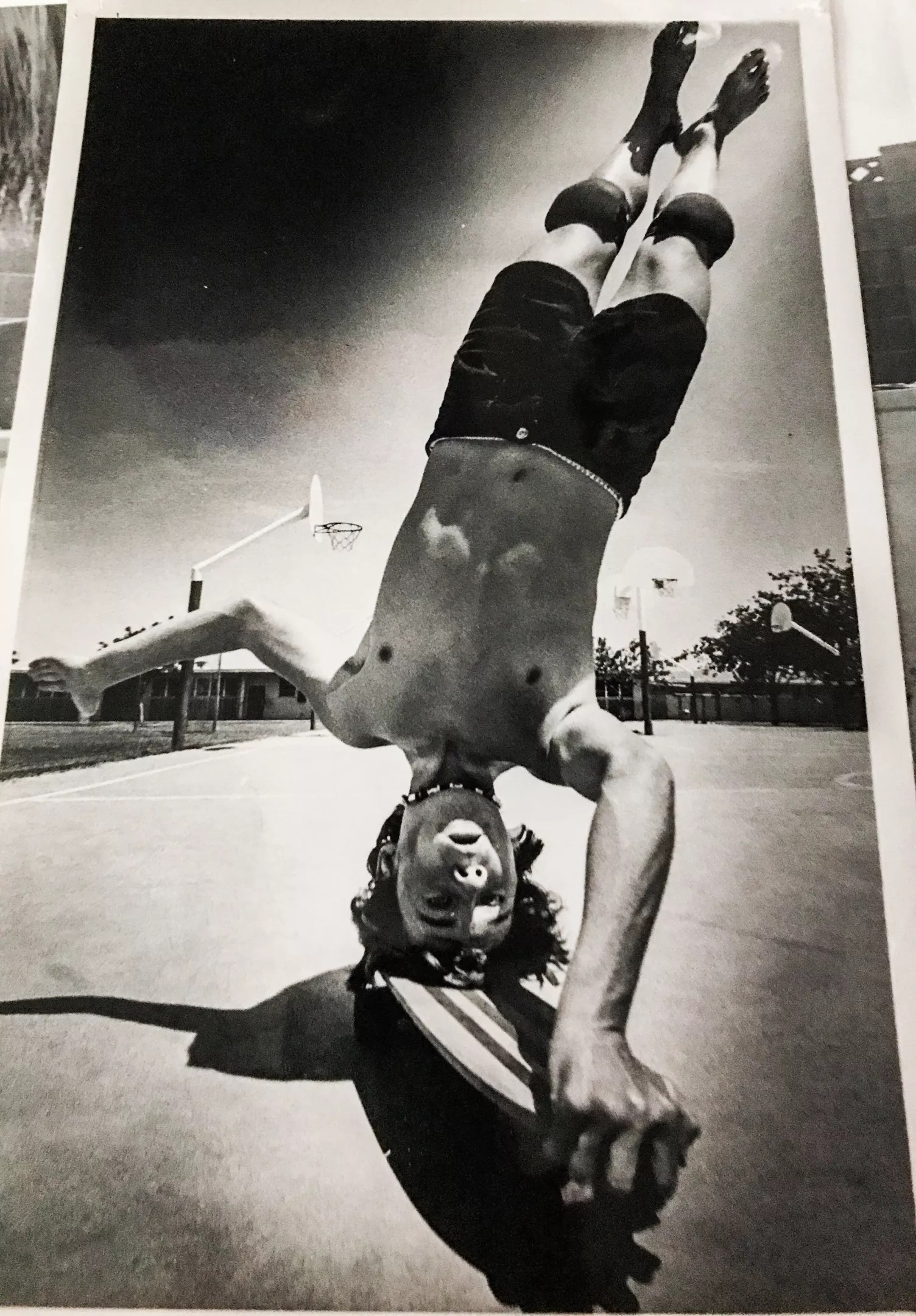
Hoss Rogers doing a “gorilla grip head stand” circa 1975.
Courtesy of Hoss Rogers
Around this same time, Simon realized skateboarding was happening again.
Simon: I was in San Diego in 1974 and there’s all these people on skateboards, and I called somebody over and looked to see what was going on because they were doing things that you can’t do on a skateboard. They were doing slides and all kinds of crazy stuff, hard turns on those downhills that run into the (Pacific) Coast Highway and I wanted to stop our trip right there.
When I got home, I got a skateboard. It was mind-blowing. So that’s pretty much how I started skating again. Then we had Skateboarder Magazine.
Skateboarder Magazine was first published in 1964 during the initial rise in skateboarding’s popularity and ran into 1965 before disappearing for a decade. In 1975, the magazine returned to publication and was published every two months into the early 1980s.
Simon: They had these pictures of people skating on banks and pools and stuff in there.
Ping: I was in grade school, and, you know, Skateboarder Magazine was out back then, and we would go to the Circle K and just pore through those magazines. We saw what those guys in California were doing, and we thought, “Hey, we got empty swimming pools right down the street.”

Mike Sola at the Wedge in Scottsdale in the 1980s circa 1985-1987.
Gavin Troy
Simon: I took a bike ride up the greenbelt in Scottsdale, you know, the Indian Bend Wash. Under the McDowell Road bridge over the Indian Bend Wash, there’s the bank. I stopped on my bike and looked at it. I turned straight around, went home and got my skateboard and came back. On the bank, there was one piece of graffiti. It said, “Hoss and Scott! Logans are hot.”
Rogers (the “Hoss” in question): What? I don’t remember that.
Simon: I knew that it had been skated because Logans were the hot skateboard at the time. The Logan Earth Ski. It was an oak, 27-inch, 6-and-a-half-inch-wide board with a kick tail.
Rogers: I don’t think it had a kick tail at the time. I remember mine was a flat piece of wood, and I cut out a piece at woodshop and bolted it to the back so I would have something to put my foot on.
Simon: Yeah, I made wood (skateboard) decks, and I was probably on one of my wood decks by that time.
Rogers: I used to make boards in high school shop and for some reason, I went through a phase where I was trying to ride the longest board I could possibly ride in the pool. There was a pool called Howard’s around that time. That was a really great pool. There’s some great photos of Howard’s with, like, everybody in the shower, standing all around. It really captures the vibe of the ’70s pools being just sitting around the deck of the pool, with cute girls in short shorts behind us.
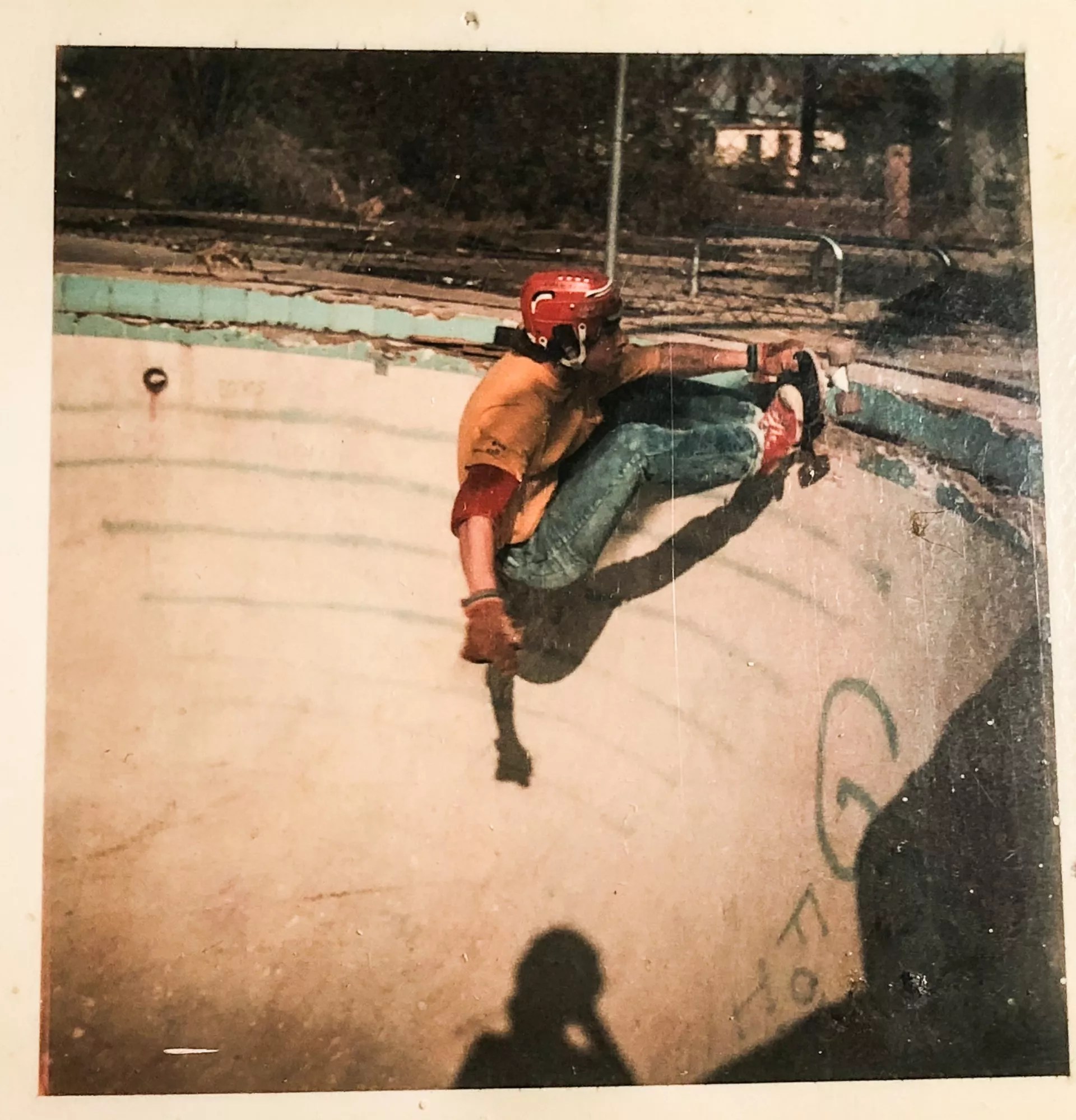
Unidentified skateboarder at the Bean Bowl in Phoenix circa 1975.
Courtesy of Hoss Rogers
Whether it was adding kicktails to their early boards or finding places to skateboard, early Valley skaters had to innovate. Skateboarder Magazine may have planted the seed for these skaters to find pools and banks to ride, but Phoenix was a concrete playground for those who liked the dry surf.
Joseph: Behind the Kon Tiki hotel, there had been a little apartment complex. The apartments were long gone, but the pool sat there, and it was pretty much bust free (a bust is a place where skateboarders can get caught and chased off). You could go there, and no one really bothered you. That’s where I met Tony (Simon). We called him Uncle Tony because he was probably in his early 20s and I was probably 13. I’m like, “Who’s this old guy?” But he was awesome and I think he drove some type of VW bus or something. He reminded me of that cartoon that was in Skateboarder Magazine, Mellow Cat.
Simon: That was the Bean Bowl, and it lasted for about five years. In the summertime, it was in the shade a lot thanks to the hotel next door. We would go and skate that thing every morning.
Shelton: I think we had the best terrain, and I think it gave us an advantage over most other kids. I would skate places, and sometimes there were kids around, but a lot of times, I was alone. A lot of people would ride a little bit, ride some pipes and some shit, but then they would wipe out and they were done. We just kept going.
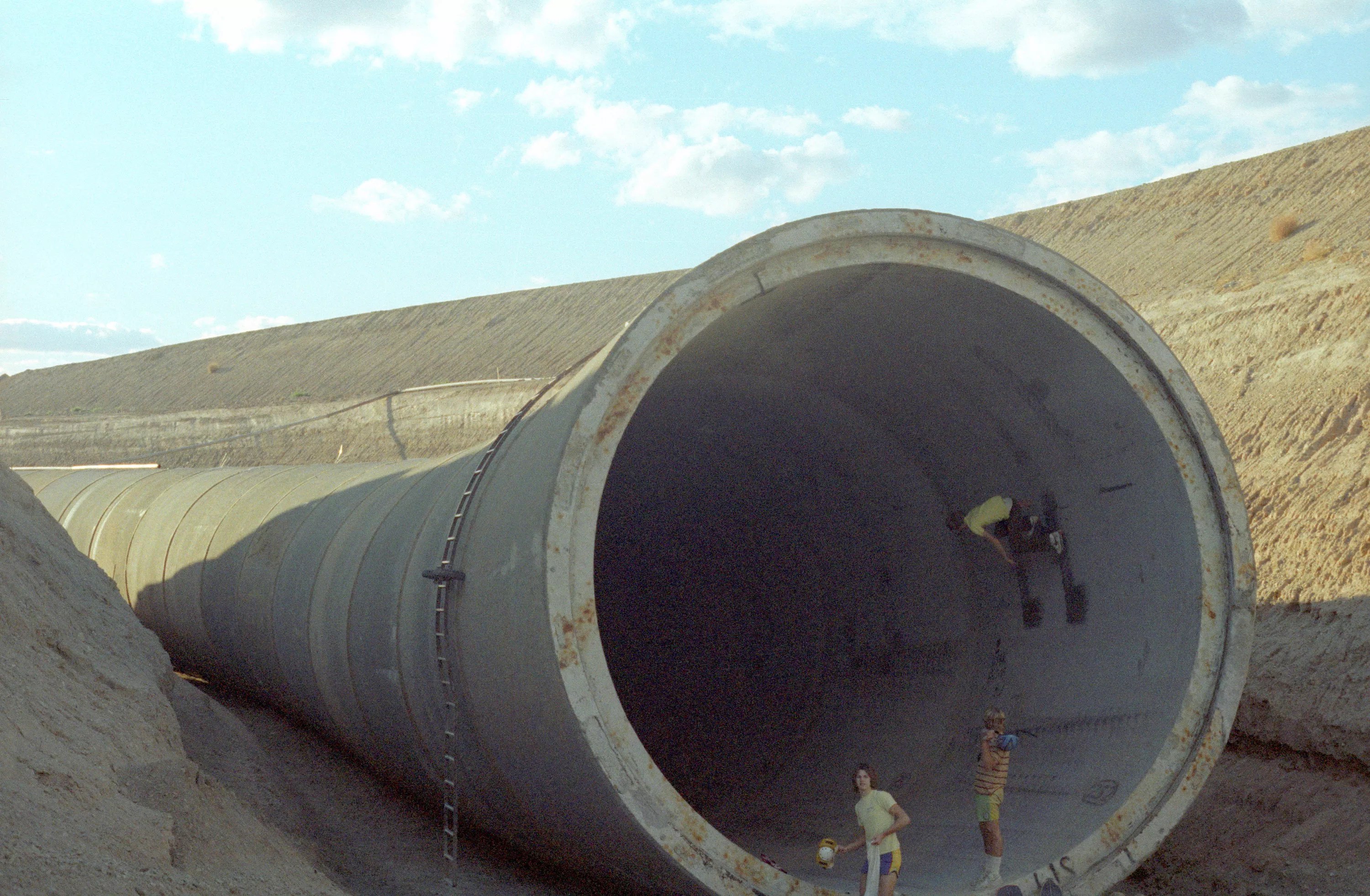
John Singleton at the Centennial pipes in 1979.
Ping
While there were dozens, if not hundreds, of pools to skate in the Phoenix area in the 1970s, it was the large concrete sections of the Central Arizona Project underground water pipes that became legendary.
Ping: I was like a freshman in high school, and I wrote to the company, Cameron, and I said, “Hey, I’m doing a book report for school. Can you send me some information (on the Central Arizona Project)?” and they sent me this big envelope full of brochures and maps and stickers. So, once we had the maps, you know, we knew wherever the canals had to go under a wash. The Agua Fria was the first one, out by Lake Pleasant, so we knew because we had the maps of the CAP and we followed it from project to project to project.
Troy: I skated with the Pingleton brothers (Steve and John) at the Florence pipes. You had to drive behind the prison to get to them. It was an insane session.
Ping: At Lake Pleasant, we were pool skaters. We didn’t really know how to kick turn (yet). Then a posse from California started coming out and showed us how to fakie (ride up the transition and go back down without turning the board) and kick turn because they had (Mount) Baldy (skate park) there.
Once we figured out how to kick turn at high speed, it was on. We were trying to carve down this pipeline, and it was so fast and so scary, you just had to hold on for dear life. There were 3-inch cracks between sections. You had to hit them when you were weightless. You couldn’t hit them going slow or at the bottom. You had to be weightless to make it over the cracks. I saw some horrible crashes.
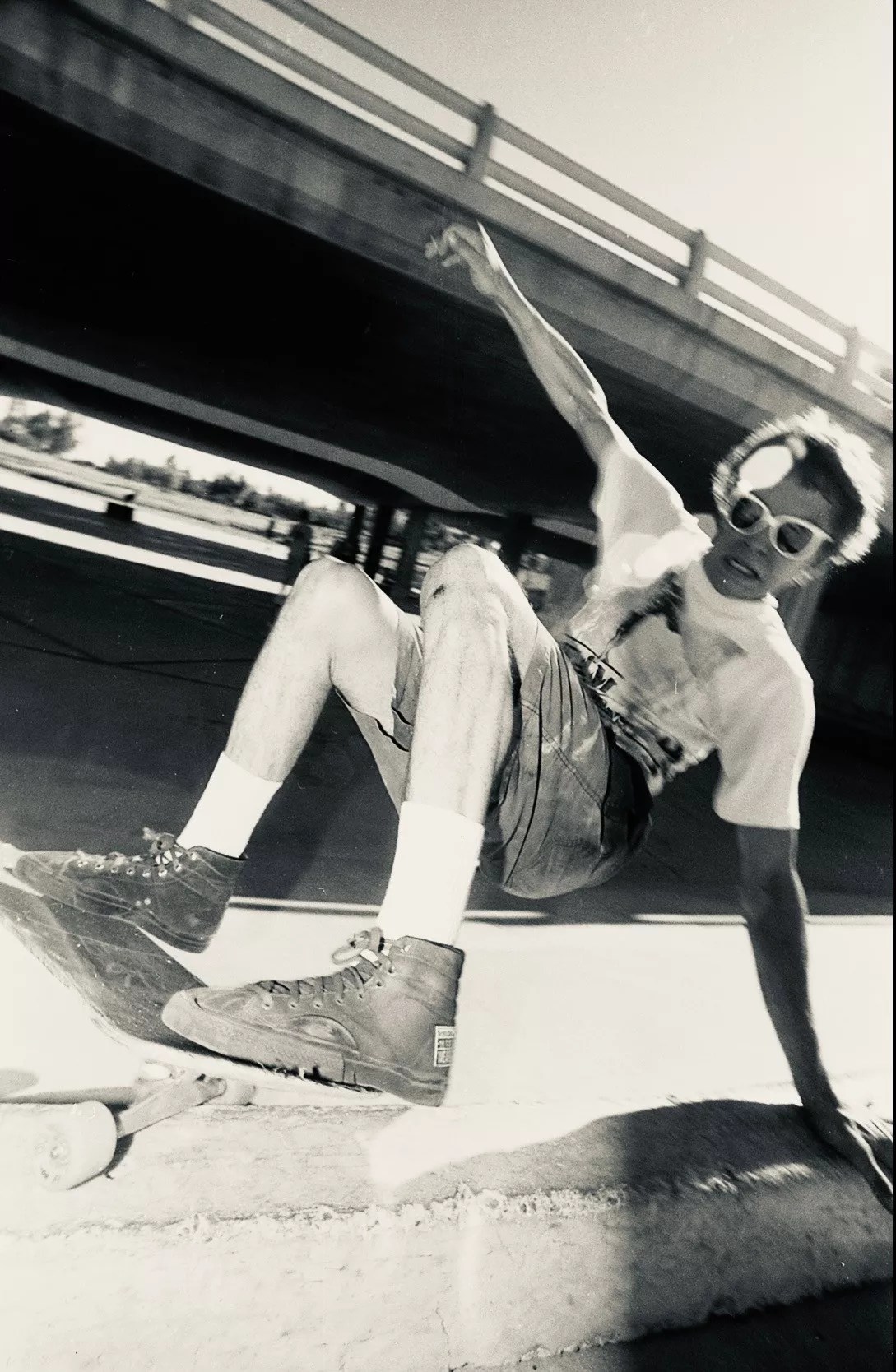
Unidentified “ripper” at the Wedge in the 80s.
Gavin Troy
Shipp: I was up at Lake Pleasant a couple of times. I would have been like, 15, and didn’t have a driver’s license yet. I was with Tony Simon and Hoss (Rogers). It was no later than 1976 or 1977. They were 22-foot pipes. It was a downhill section, at about a 30-degree angle, with gaps in the wall. I remember watching a kid on a big wheel trike going back and forth down the thing … and he fell. It was so dark down there, too.
Shelton: The pipes were challenging. I liked that. Just that sound in there, you know? The “thump, thump” going over over the seams. There were some wipeouts … the one thing, if you were going to bail, you better stay close to the wall. If not, you were taking the full fall.
Rogers: Falling out, man, that was like an 11-foot fall. The pipes were real.
Simon: They made the skate scene in Arizona go completely berserk. Before we knew it, all the pros from California were coming out and the level of skateboarding skyrocketed. I wasn’t there the first time the pros came, but I heard about it from some west-siders. They taught us how to skate the sections and get over those gaps.
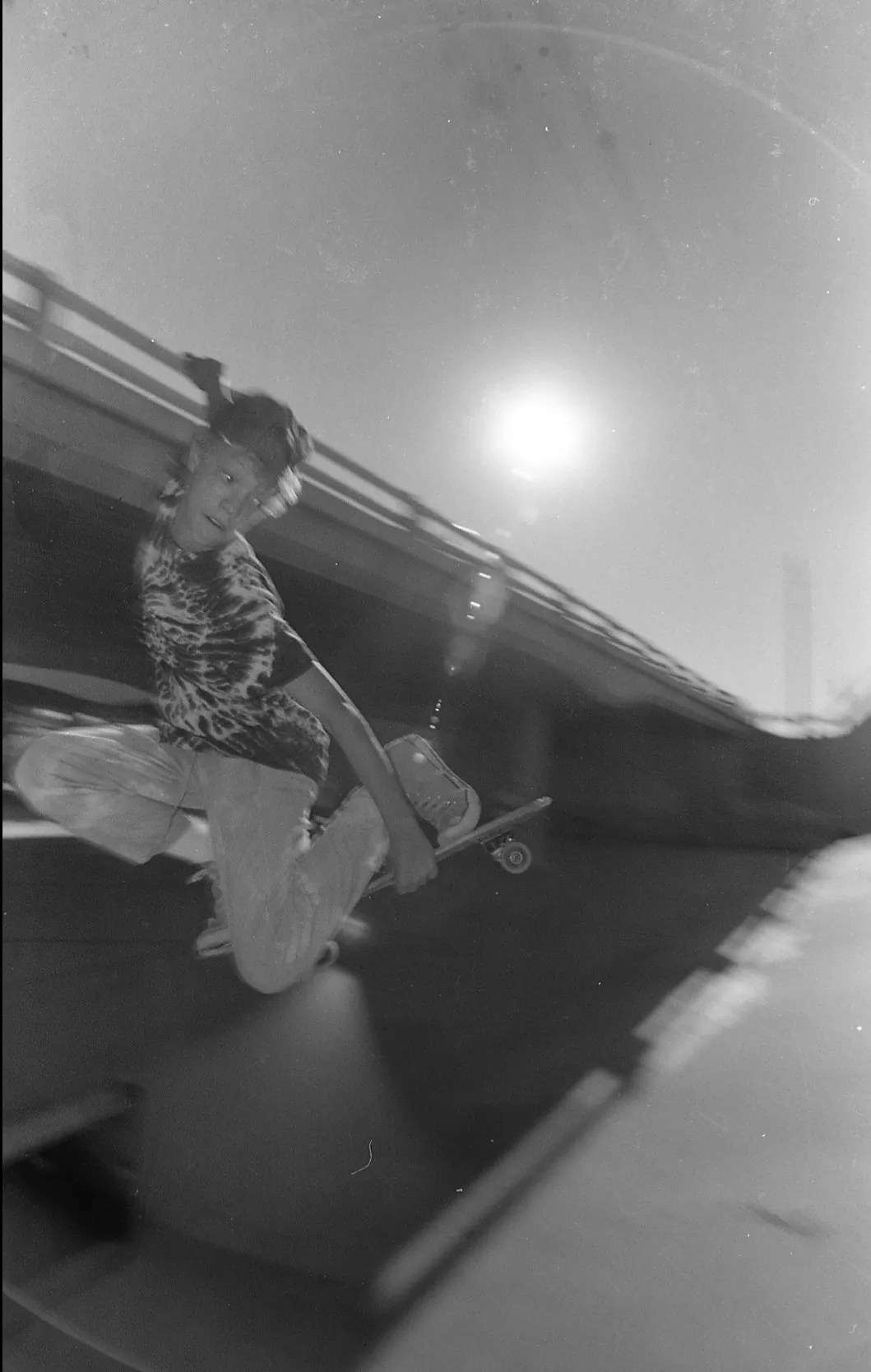
Mike Taylor at the Wedge in Scottsdale in the 1980s.
Gavin Troy
Brannon: I remember one time I said, “I’m gonna see how fast I can go on this thing, see how high up I can get.” Going fast, that was my thing back then, and whenever I got uncomfortable, I just grabbed the nose (of the skateboard). That was kind of like my safety blanket.
So, I’m just zooming in and out, down the line, doing a kind of backside kick turn and going up front side (with the back towards the bottom of the pipe) with all this speed and no way to scrub it off. I was like, “Oh, man, grab the nose.” So, I grabbed the nose and all four wheels came off the wall and only my (board) tail was skidding on the wall over vert. I just held onto this tail slide and didn’t let go because the nose was my safety blanket. I don’t know if anyone saw it, but I certainly wasn’t going to do it again.
“Dry Surf: Local Skateboarding History” continues at Tempe History Museum, 809 E. Southern Ave., Tempe, through Jan. 31, 2026. Hours are 10 a.m. to 5 p.m. Tuesday through Saturday. Admission is free.